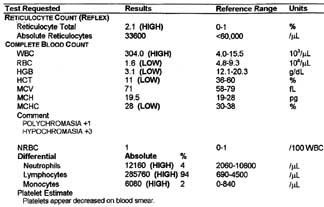Lab work can tell a great deal about what’s going on with your cat’s or dog’s body. It’s not difficult to imagine that lab work is essential to determine how well a diet is working. We rely on this kind data to fine-tune diets so we can achieve the desired nutritional outcomes.
When you receive a copy of the lab results, it’s a couple of pages filled with unfamiliar abbreviations, terms, and all kinds of numbers. That’s enough to think about right there. But there’s more to consider.
Some lab tests are straightforward, providing a simple “yes” or “no” answer. For instance, was the test positive for Feline Immunodeficiency Virus (FIV) or heart worm.
Most other tests, however, are reported as numbers or values. Laboratory test results reported as numbers are not meaningful by themselves. Their meaning comes from comparison to reference values. Reference values are the values expected for a healthy animal. They are sometimes called “normal” values and are associated with a normal range. The lab values from your baby either fall within the ‘normal’ range, are above the range (a high result), or fall below the range (a low result).
To determine ranges, and what’s ‘normal’, labs may conduct their own studies for the tests they perform, they may adopt reference ranges from test manufacturers or other labs, or they may derive reference ranges from existing patient data.
There can be lab-to-lab variability which can occur due to differences in testing equipment, chemical reagents used, and analysis techniques. Consequently, for most lab tests, there is no universally applicable reference value. Comparing a lab result from lab A, to the same test from lab B, may show a different value.
Lab ranges are determined by reference values based on statistical ranges in healthy dogs or cats. These are typical dogs and cats and they’re fed a typical diet. These lower are protein diets from kibble and/or canned foods, versus a higher raw protein diet from whole, fresh ingredients. (Raw diets are fed to about 5% of the dog and cat population, meaning raw is far from a typical diet.)
One example, Creatinine is produced as a natural byproduct of muscle activity and is removed from the blood by the kidneys. Creatinine is often measured as a gauge of how well the kidneys are functioning. Creatinine levels are affected by an animal’s muscle mass. Because males have greater muscle mass than females, younger animals have more muscle mass than aged animals, the reference values can vary.
Then there’s the time that’s passed between the last feeding and the blood or urine draw. The stress the animal experiences getting to and being at the vet can have a big impact on various chemical levels in the blood. All these things and more can cause the results to fluctuate outside of what may be ‘normal’ for your animal.
Further, feeding a natural raw diet can lead to some elevated lab values. Creatinine has been mentioned, but BUN can run slightly higher on a high protein diet also. BUN can change depending on the amount of protein in the diet. A slightly elevated value related to protein metabolism isn’t necessarily indicative of kidney or other issues. Only your vet can determine that.
In summary, there is a great deal to consider when looking at labs. Your vet can help, but it’s important to understand some of the factors that can produce variation in results so you can ask the right questions. Make sure to take outlying results in context and not treat them as absolute. In the end, you’re the one responsible for making the health decisions for your dog or cat, so having all of the information and considerations will produce a better decision.

In recent years, pet owners have become increasingly concerned about the quality and nutritional value of the food they feed their furry companions. One trend that has been gaining popularity is the use of hydrolyzed ...
Introduction As pet owners, we are constantly seeking ways to improve the health and well-being of our beloved furry companions. One aspect that has gained significant attention in recent years is the use of herbal ...
As we move through this holiday season and towards the new year, we’ve been stuffing our faces as we prepare to stuff our stockings! You might already be at the point where you are loosening ...